- Home
- Aaron Allston
Terminator 3--Terminator Dreams
Terminator 3--Terminator Dreams Read online
The author and publisher have provided this e-book to you without Digital Rights Management software (DRM) applied so that you can enjoy reading it on your personal devices. This e-book is for your personal use only. You may not print or post this e-book, or make this e-book publicly available in any way. You may not copy, reproduce, or upload this e-book, other than to read it on one of your personal devices.
Copyright infringement is against the law. If you believe the copy of this e-book you are reading infringes on the author’s copyright, please notify the publisher at: us.macmillanusa.com/piracy.
Contents
Title Page
Copyright Notice
Dedication
Acknowledgments
Major Players
Prologue
C.1
C.2
C.3
C.4
C.5
C.6
C.7
C.8
C.9
C.10
C.11
C.12
C.13
C.14
C.15
C.16
C.17
C.18
C.19
C.20
C.21
C.22
C.23
C.24
C.25
C.26
C.27
Epilogue
Books by Aaron Allston
About the Author
Copyright
This novel is for everyone—family, friends, and people I’ve never met—who manage to get the job done, even when their own machinery is a bit suspect.
ACKNOWLEDGMENTS
Thanks go to Russell Galen, my agent, and James Frenkel, my editor; Kelly Frieders, Kali Hale, Helen Keier, Beth Loubet, Cindi Manning, Susan Pinsonneault, Jennifer Quail, Bob and Roxanne Quinlan, and Sean Summers, my Eagle-Eyes, the sharp-sighted folk who diminish the number of errors I introduce into each manuscript; and Steph Chiesi, Jenn Hussong, Derrick K. Johnson, Erin M. Lopez, and Luray Richmond, for offering facts when they were hard to come by.
MAJOR PLAYERS
YEAR 2029, HUMAN RESISTANCE
John Connor, leader
Kate Brewster, leader
Michaela “Mike” Herrera, scientific adviser
Daniel Ávila, programming adviser
Dr. Tamara Lake, medical adviser
Resistance 1st Security Regiment:
Colonel Sidney Walker, commander
Lieutenant David “Ten” Zimmerman, squadron leader, Hell-Hounds (Company A, Squadron 3)
Earl Duncan, Hell-Hounds
Mark Herrera, Hell-Hounds
Kyla Connor, Hell-Hounds
Ripper, Hell-Hounds
Ginger, Hell-Hounds
PRESENT DAY
Danny Ávila, programmer, Cyber Research Systems (CRS)
Linda Ávila, deputy, Kern County Sheriff’s Department
Teresa “Mama” Ávila
Lieutenant General Robert Brewster, head of operations, CRS
Dr. Philip Sherman, lead programmer, CRS
Jerry Squires, programmer, CRS
PROLOGUE
June, Present Day
Edwards Air Force Base, California
Cyber Research Systems (CRS) Autonomous Weapons Division
“Daniel Ávila, it is time to die.” The voice was harsh, mechanical.
Danny raised his head and stared into the eyes of a Terminator.
This was a mechanical face, skull-like in its angles, merciless and pitiless. It was the face of the prototype Terminator that Danny’s team was in the process of programming, transforming it from mere servos and articulated metal into the next stage in American armed might, an unstoppable combination of mobile artillery, mechanized cavalry, and infantry.
It was a very familiar face. When initially assembled, the armored faceplate assembly had been attached slightly misaligned to the armored skeleton and sensory apparatus beneath. The result was that the right eye rode a little high in its socket, giving the Terminator’s face an oddly human scowl. Hence the robot’s nickname, Scowl.
And it was, ultimately, a two-dimensional face, devoid of the menace of immediacy. This was nothing more than the graphic on Danny’s computer desktop, an image converted from recordings made during one of Scowl’s trials.
But desktop images didn’t ordinarily talk. Still groggy from falling asleep at his workstation, Danny looked around at the interior of his oversize cubicle—and flinched from the figure looming over him.
His coworker, a lean man with a high forehead and pointed chin, laughed at his reaction, then resumed his ersatz Terminator voice: “Or maybe just to go home.” He cleared his throat and resumed a normal voice. “What are you trying to do, make the rest of us out to be slackers?”
“What?” Danny was having trouble focusing. For a moment, he couldn’t even remember his coworker’s name. For a man with a near-photographic memory, this was more than distressing. Finally it came: Jerry, the man’s name was Jerry.
Jerry bent over to point at the clock running in the lower corner of Danny’s monitor. “Look. Seven P.M. Long past the time to go home. You’ve been here for a day and a half with barely time for bathroom breaks. You’ve inflicted a mortal wound on the bug-fix list. When the brass gets its next look at Scowl, they’re going to be thrilled. They’ll sound like cheerleaders. But you need some sleep.”
“Wait.” Danny shook his head, focusing on the clock on his screen. For once in his life, he didn’t automatically know the time, and he didn’t believe the words and numbers on his monitor. “Friday? It’s Thursday.”
“Uh-uh. You just put in thirty-plus hours of genius labor, kid. Are you fit to drive home?”
“Of course,” Danny responded automatically.
“Well, then. See you Monday.” His coworker clapped him on the back and left the cubicle.
Danny rose. He remembered getting to work, of course. But that had been Thursday morning. He couldn’t remember anything that had happened since. So where had the last day and a half gone?
He stared into the eyes of the Terminator on the screen. Despite the fact that the prototype robot was something he was programming, nothing but a tool that was soon to revolutionize the U.S. military, nothing but a rolling weapon with an approximately human set of features, he was suddenly afraid of it. There was pitiless cruelty in its eyes where there never had been any before.
He reached over to switch the monitor off. “Problem solved,” he said.
But as he headed out of Cube Hell, the programmers’ pit, for the elevator that would take him to surface level, he knew that the Terminator’s eyes would be waiting for him the next time he came to work.
And for the first time ever, he didn’t look forward to seeing them again.
C.1
August 2029
San Rafael, California
Population 0
It wasn’t exactly a jungle, but in the decades since Judgment Day, trees had forced their way up through street pavement and sidewalk concrete; grasses and weeds had overrun lawns and medians. Now, where on a normal afternoon traffic sounds would have once drowned out every other noise, John Connor could hear only the summery rise and fall of insects calling to one another. That, and the occasional bang or clank or curse from the crew working behind him.
He stood at the open loading door, looking out into the overgrown parking lot. There were still some cars here, left behind when the world went to hell decades ago, but they shared the lot with aggressive waist-high weeds and, wonder of wonders, a lemon tree that had taken root at the corner of the property.
John felt a bit like the parking lot. His wife still told him his face was hands
ome; that his upright posture, his camo-style uniform, all projected the image of a leader of men, grayed but unbending. But on days like this he could feel every injury that he had sustained in his fifty-plus years—every gunshot wound, every broken bone, every burn. Scars, new and old, marked his body like weeds marked the parking lot, and there were more every year.
Even so, he needed to lead the occasional mission in the field. He was the leader of the Resistance, and decades of experience made it clear to him that the men and women he commanded would lose faith in a commander who always sat safely in his hardened underground bunker at Home Plate compound, dispatching others to their deaths. To keep spirits up, to keep himself from becoming some sort of distant, unattainable figure who never met and therefore could never inspire the troops elsewhere, he had to expose himself to danger a few times each year.
He couldn’t complain. There were men and women in his forces—including his own children—who exposed themselves to danger several times a month. There were some who almost never had the opportunity to relax, to feel safe.
“Hey.” The voice was female. He glanced over his shoulder at the speaker.
She stood a few feet behind him, just beside the angled column of light spilling in through the loading door, and it took his eyes a moment to adjust so he could make out her features. She was of average height and build, but he didn’t find her in the least average. Her nose was just a little too broad to be considered elegant; but that, her round face, and her mouth—made for smiling—added up to a combination that was impossibly attractive. Her eyes were dark brown, her hair graying from the same color. She wore a camo uniform like his, though she’d set aside the belt with its holsters and pouches.
He modulated his tone to that of an office lothario. “Hey, yourself,” he said. “Are you new?”
She grinned, taking on the cuteness of a teenager. “First day here.”
“What are you doing after work?”
“I was thinking about a long moonlit drive with a bunch of sweaty freedom fighters.”
He offered her a mock shudder. “Well, I guess a girl’s got to do what makes her happy.” He dropped the act. “How’s it going back there?”
“They’ll be ready for the fourth truck in about two minutes. They wanted me to tell you to send out the call.”
“Will do.”
She turned away, toward the dark interior of the loading dock. He reached out and caught her by the shoulder, dragging her back to him. Off-balance, she fell into his grasp, simultaneously grinning and scowling up at him. “What?”
“Kate, you know the price for approaching this checkpoint.”
She leaned up to kiss him. “There. Does everyone who passes this way have to do this? Earl? Warthog? Crazy Pete?”
“I dunno. It’s a brand-new policy.”
Laughing, she shrugged free of him and headed back into the manufacturing facility.
John stared after his wife for a moment, savoring the bare minute of privacy they’d shared, perhaps the only minute they’d have this day. Then, reluctantly, he turned his mind back to business.
The building they were pillaging, a sprawling, nearly windowless single-story edifice larger than a football field, had once been decorated with a sign that read, EOSPHOR TECHNOLOGIES. Before Judgment Day, it had been a circuit board manufacturing concern, a subcontractor that built boards for companies that sold munitions components directly to the government. The sign had fallen, possibly on Judgment Day, possibly many years later. For whatever reason, the interior of the building had survived unpillaged for decades, and one of Connor’s scouts had discovered it a few weeks ago. Two days ago, Connor’s advance team had arrived and begun preparing selected pieces of equipment for transportation.
They couldn’t take everything. A rough estimate of the amount of equipment here suggested that it would take a convoy of forty trucks or more to move every item of machinery, all surviving chemicals, all fabrication supplies. He had five trucks, a massive and vulnerable convoy by the standards of the Skynet-controlled world. So they had to be selective.
The equipment his technical team was dismantling and preparing for transportation included computers that his programming adviser Ávila had said still worked, still contained diagrams for hundreds of varieties of circuit boards. There was a room-size plotter that could transcribe those circuit board plans onto sheets of silver-coated Mylar at photographic levels of reproduction, for use in exposing circuitry images onto copper-clad fiberglass laminates. There were photographic exposure units, some merely oversize and ungainly, some large enough nearly to fill the back of a two-and-a-half-ton truck. There were rugged, hardy screen printers for use in silkscreen processes, usable both for circuit board manufacturing and more mundane tasks such as cloth decoration. Last of the primary haul, but certainly not least in size, were laminate presses that turned individual layers of laminates into multilayer circuit boards.
Less crucial to circuit board fabrication but still useful to the Resistance were control computers for sophisticated drill processes, laboratory equipment, tools, components for setting up partitions and metal cage walls, and parts scavenged from dozens of machines.
The booty from this haul, augmented by equipment that John’s technicians would assemble on site, would allow the Resistance to set up two entire circuit board fabrication lines. That meant two sites that could produce radios, targeting systems, even computers someday. The lines would be much slower, much less efficient than those operating before Judgment Day, but they’d be a tiny edge in the favor of humanity, a fraction-of-a-percentage improvement in mankind’s chances for survival. The Human Resistance had other circuit board fabrication sites operating, but every additional one they set up increased their available resources.
And with luck, the Eosphor Technologies building would go unnoticed by Skynet even after their departure. A few months from now, perhaps a year, they might be able to return and pick up even more equipment.
He pulled his field phone from its belt pouch. Shaped much like one of the walkie-talkies he’d known from his youth, it seemed cruder, more unfinished than the commercial products of the twentieth century. Its surfaces were black-painted metal instead of molded plastic. A cable ran up from a jack atop the device to the headset John wore and the microphone on his lapel.
With his thumb, he popped open the protective faceplate, revealing a small LCD screen and an alphanumeric keypad. He keyed in the following commands:
TRANS STARLING ALL‹ENTER›
AC 4T‹ENTER›
OFF‹ENTER›
This operation was code-named Starling, a random word generated by a computer program back at his base of operations. The first command had instructed the simple microprocessor in the device to send the rest of the message only to the participants in the operation. “Ac 4T” was shorthand for “activate fourth transport.” The entire transmission would be encrypted when transmitted.
It would have been much easier to have depressed the speaker button on the faceplate, or to have keyed the microphone attached to his lapel, and spoken the appropriate words. But a voice transmission took much more time to transmit than his five-character code, was easier to detect and decode, and was less likely to be mistaken for an atmospheric anomaly. A voice transmission would, in short, drastically increase their odds of getting someone killed.
And there just weren’t enough people left alive for him to let himself be careless that way.
* * *
Half a mile to the south, four figures huddled under a tarpaulin on a rooftop. They were situated at the edge of the roof where some long-ago calamity had knocked away a portion of the waist-high protective wall. The hole gave them an unobstructed view of the city’s ruins southward.
Kyla Connor, the woman with her eye to the sniper rifle’s high-powered scope, was young, not yet quite out of her teens. Her dark brown hair, a practical shoulder length, was tucked up under her billed cap. Her features were even and flawless; at rest,
as they were now, they were unmemorable, but when lit by one of her rare smiles, they were transformed into earthy beauty. She wore the same camouflage uniform as most of the other participants in Operation Starling.
Her field phone beeped softly, but she didn’t stir. “Mark, get that, would you?” she whispered.
Mark Herrera, the man lying on his back beside her, yawned and stretched. He was darker than the woman, Latino, with everyday good looks that seemed made to wear their current expression, an amused and self-satisfied smile. He was perhaps a decade older than she, but with his more casual attitude he actually seemed younger. “Sure, sure. I wasn’t doing much. Just getting my first sleep in twenty hours.”
“God, you complain.”
He pulled out his field phone and popped the faceplate open, then tilted the device to read the screen in the dim light spilling in past the tarpaulin’s edge. “It’s your dad. Calling in the fourth truck.”
“Ahead of time. That’s good.”
The third member of their post offered up a concerned whine. Kyla didn’t break discipline; she kept her attention focused on the scope, which was trained through a break in the buildings ahead on a stretch of what had once been U.S. 101. But she did reach a hand back to scratch the whiner behind the ears. This was Ginger, eighty pounds of reddish-yellow Siberian Husky or Alaskan sled dog and who-knows-what, and she was a bit more anxious than Kyla’s other dog, Ripper. Ripper, lying sideways across the backs of Kyla’s knees, was 120 pounds of deep-chested, flat-faced guard dog. Kyla’s mother, once a veterinarian, said she thought he was mostly bullmastiff; but his coloration was evidence that he was not purebred. Ripper, seeing Ginger getting attention, wagged his short tail, making a thumping, rattling noise against the gravel of the roof.
“How long till dinner?” Mark asked.
Kyla restrained a sigh. Mark was just baiting her. “Why don’t you go out there and see if you can find an open restaurant?”
“Oh, good one. Of course, I might find a can of thirty-year-old, not-too-radioactive corned beef hash—”
There was something in the view afforded by her scope, something moving in the distance up the highway, and Kyla stiffened. “Hold it. Contact.”

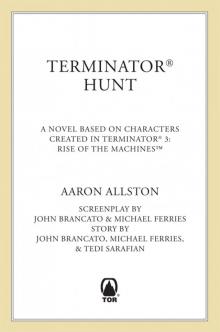 Terminator 3--Terminator Hunt
Terminator 3--Terminator Hunt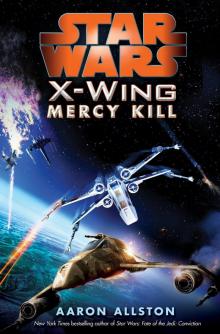 Mercy Kil
Mercy Kil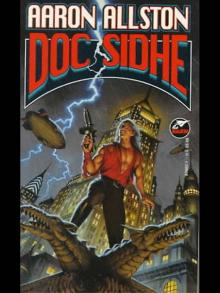 Doc Sidhe
Doc Sidhe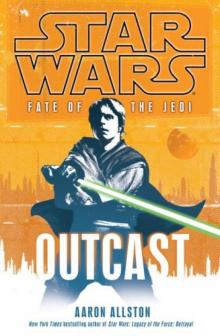 Star Wars: Fate of the Jedi: Outcast
Star Wars: Fate of the Jedi: Outcast Fate of the Jedi: Backlash
Fate of the Jedi: Backlash Mercy Kill
Mercy Kill Rebel Stand
Rebel Stand Wraith Squadron
Wraith Squadron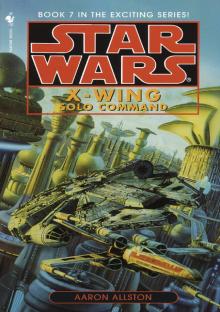 Star Wars: X-Wing VII: Solo Command
Star Wars: X-Wing VII: Solo Command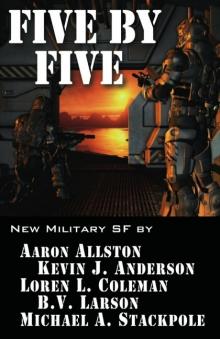 Five by Five
Five by Five Solo Command
Solo Command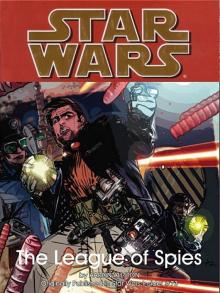 Star Wars: The Clone Wars Short Stories: The League of Spies
Star Wars: The Clone Wars Short Stories: The League of Spies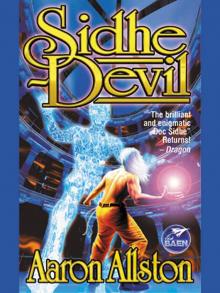 Sidhe-Devil
Sidhe-Devil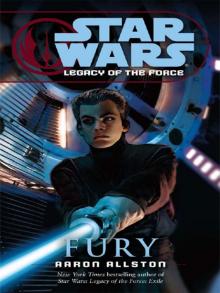 Star Wars: Legacy of the Force: Fury
Star Wars: Legacy of the Force: Fury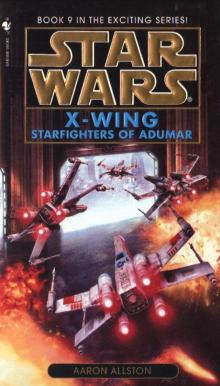 Starfighters of Adumar
Starfighters of Adumar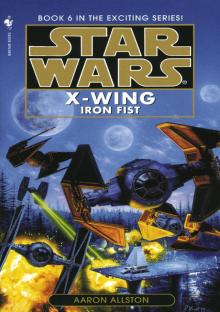 Star Wars: X-Wing VI: Iron Fist
Star Wars: X-Wing VI: Iron Fist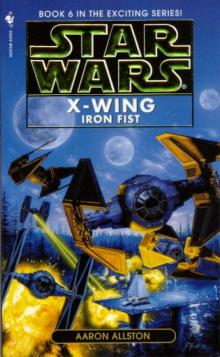 Star Wars - X-Wing - Iron Fist
Star Wars - X-Wing - Iron Fist Exile
Exile Star Wars: X-Wing V: Wraith Squadron
Star Wars: X-Wing V: Wraith Squadron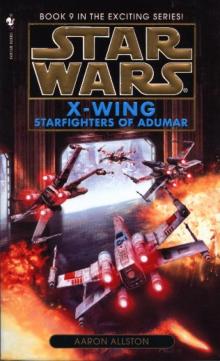 Star Wars - X-Wing - Starfighters of Adumar
Star Wars - X-Wing - Starfighters of Adumar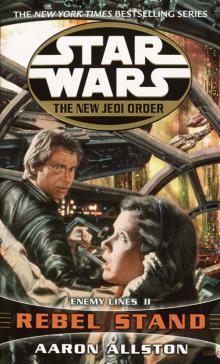 Rebel Stand: Enemy Lines II
Rebel Stand: Enemy Lines II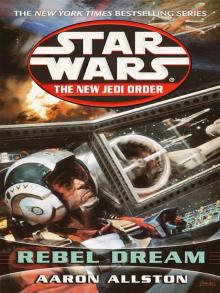 Rebel Dream: Enemy Lines I
Rebel Dream: Enemy Lines I Outcast
Outcast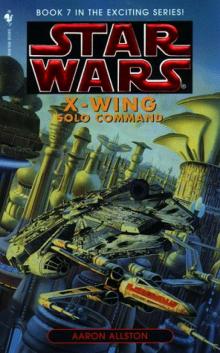 Star Wars - X-Wing 07 - Solo Command
Star Wars - X-Wing 07 - Solo Command